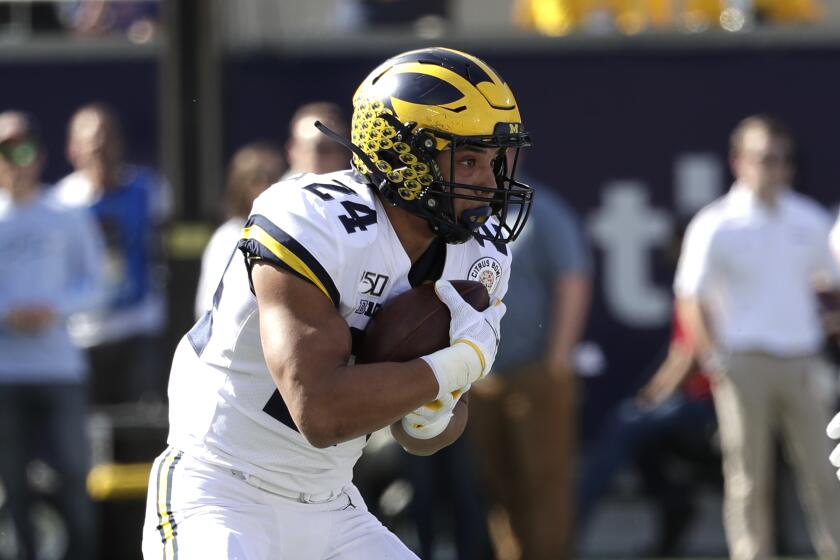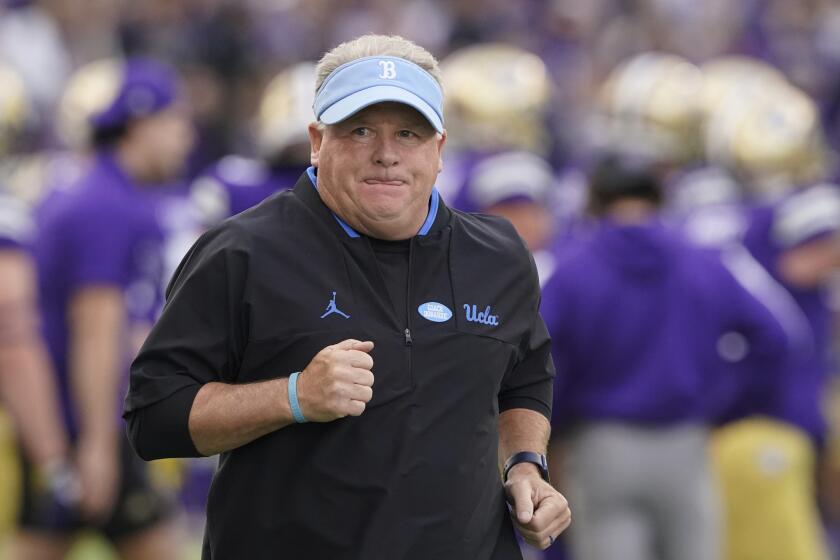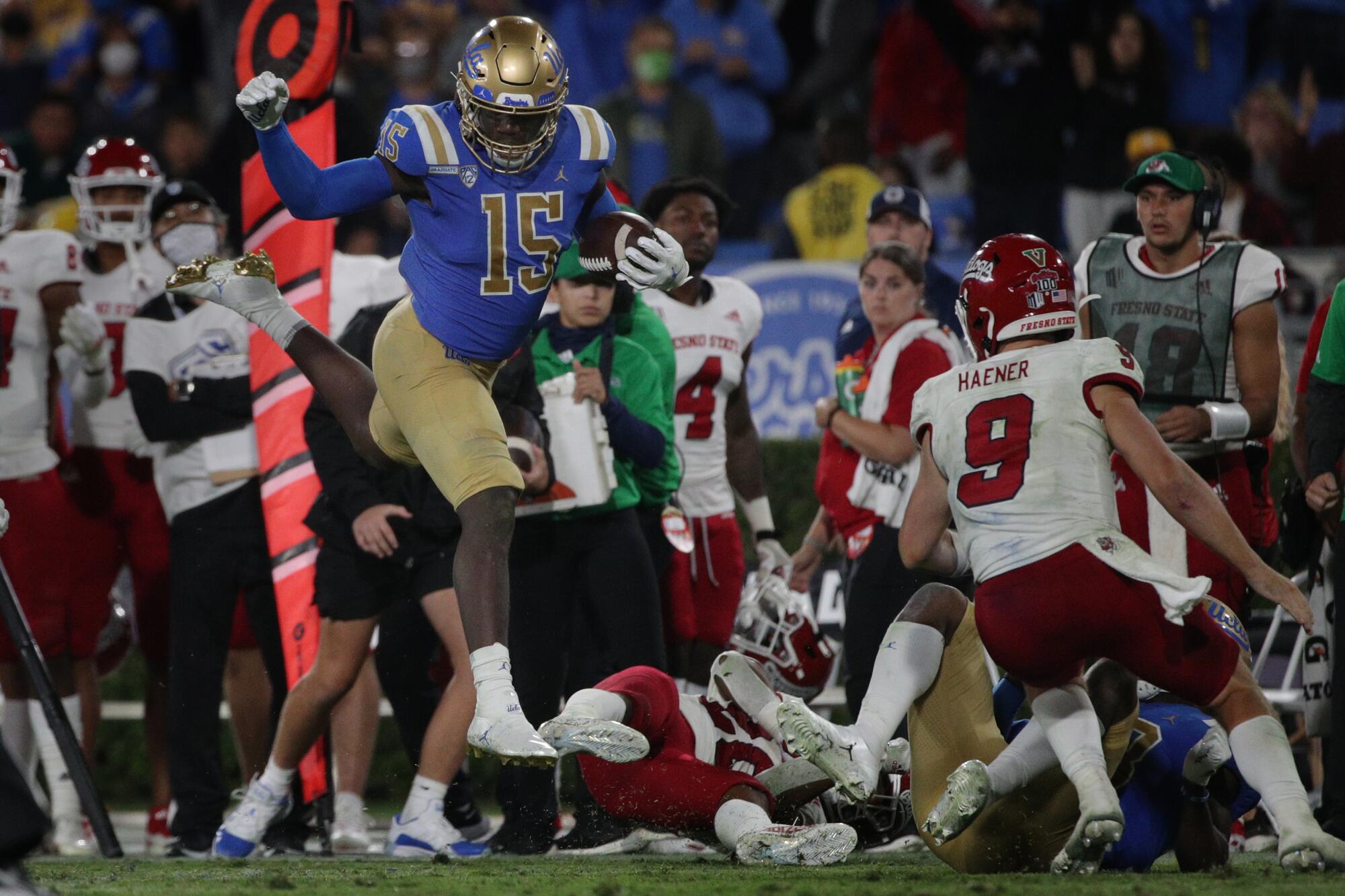
- Share via
A three-star prospect out of San Diego’s Cathedral Catholic High, Jordan Genmark Heath drew interest from dozens of schools in 2016. UCLA, with former coach Jim Mora, was one. The Bruin coaches who molded Anthony Barr and Eric Kendricks into first and second-round draft picks, respectively, pitched Genmark Heath the possibility of growing into the school’s latest linebacking star.
Thanks, but no thanks, he said. Genmark Heath was a “safety at heart.”
“Four years later, I’m playing linebacker here,” the Notre Dame graduate transfer said while sitting on a chair on the side of UCLA’s Spaulding Field. “So I guess it was always meant to be.”
Zach Charbonnet and Jordan Genmark Heath, transfers from Michigan and Notre Dame, have boosted UCLA and aim to help the Bruins ‘shock the Pac-12.’
Transfers like Genmark Heath are getting a second lease on their football careers. What used to be one-off additions are now critical building blocks for UCLA and USC as the transfer trend only grows in college football.
The Bruins (5-2, 3-1 Pac-12 Conference) have 16 transfers, including nine in their starting lineup. Seven, including Genmark Health, are defensive starters. They are preparing to host No. 10 Oregon Saturday, with ESPN’s “College GameDay” broadcasting from Los Angeles ahead of the contest.
After several players entered the transfer portal and the NFL draft, USC (3-3, 2-3 Pac-12) reloaded with nine transfers this year, including former Texas running back Keaontay Ingram, the team’s rushing leader, and former Memphis receiver Tajh Washington. USC has 24 total players who started their college careers elsewhere. The rebuilding Trojans play at No. 13 Notre Dame Saturday.
But for every transfer who finds a second college football home, there are dozens still in portal limbo. There are nearly 2,000 college football players currently waiting for the call, according to 247Sports’ transfer portal tracker, from Division II prospects looking for bigger opportunities to forgotten four-star prospects at Power Five schools trying to keep their careers alive.
Darwin Barlow was one of the latter. The USC running back was the fourth-best rated running back in Texas coming out of high school. He took a long look at USC, but, at 17, felt Los Angeles was too far from his hometown of Newton, Texas. Texas Christian allowed him to stay closer to his family.
Barlow ran for 527 yards in 95 carries with five touchdowns in two seasons with TCU, but a breakout season from freshman Zach Evans in 2020 made Barlow an afterthought. The junior turned to the portal.
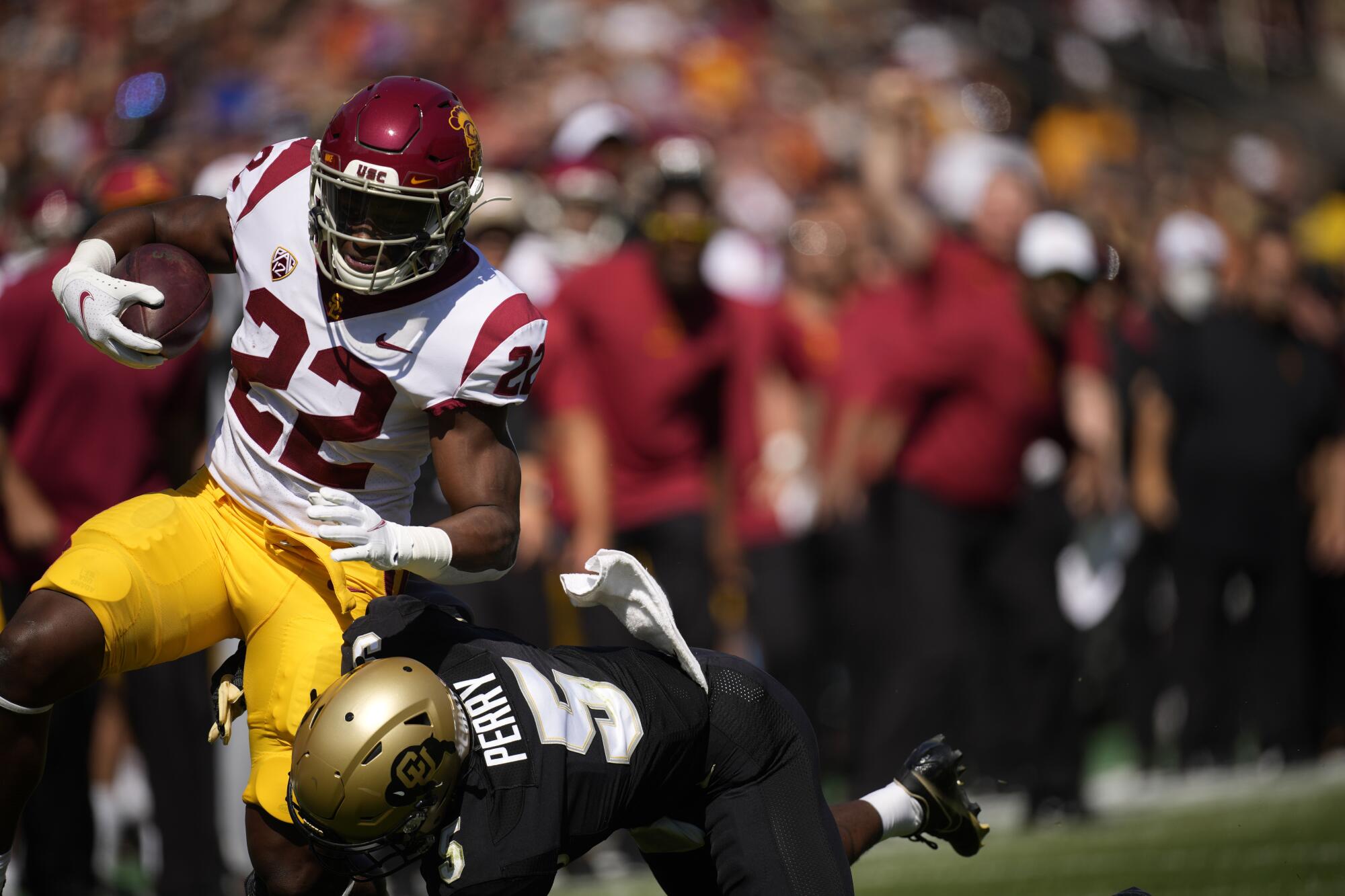
After initially passing on USC because of the location, 1,700 miles didn’t seem too far in Barlow’s mind anymore.
Barlow, who is USC’s third-leading rusher with 112 rushing yards in 19 carries, knows he wouldn’t have survived all four years at USC if he committed out of high school. At 20, he can shake off the homesickness because of the experience he gained at TCU.
“You go through things and you learn from them or you can keep making the same mistakes,” Barlow said. “Coming here, I knew the coaches before, so I was sure I trusted them and I’d seen the plan down the road.”
Previous relationships are lifelines for players trying to escape the portal and coaches trying to sort through thousands of hopeful transfers. Some coaches call UCLA’s Chip Kelly if they have a player who could fit the Bruins, like Notre Dame’s Brian Kelly did when Genmark Heath entered the portal. Genmark Heath leaned on his own connections by asking UCLA receiver and fellow San Diego-area prospect Kyle Philips for insight.
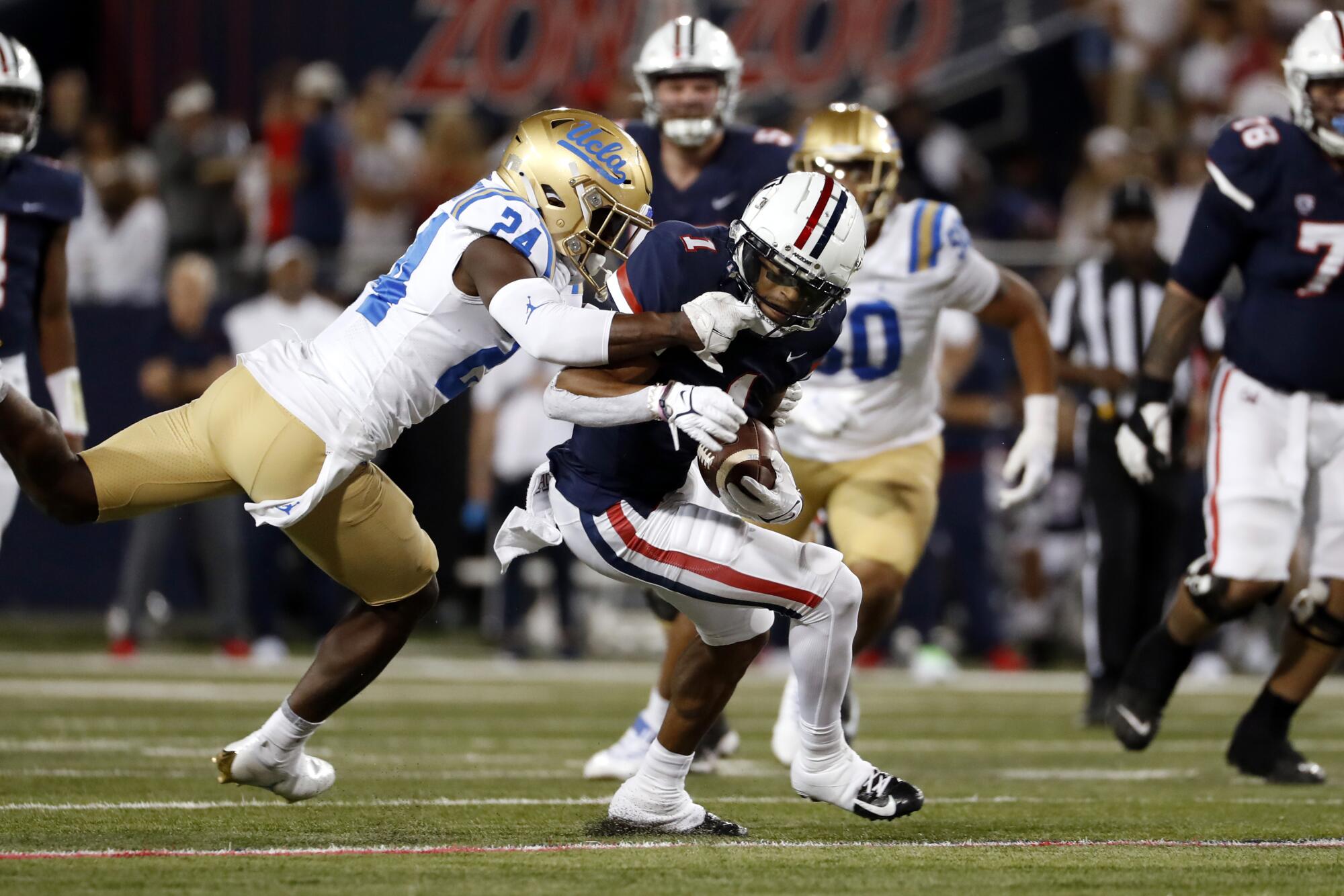
Barlow is one of seven 2021 USC transfers who went to college or high school in Texas, a reflection of the coaching staff’s deep ties to the state. Six Trojan coaches played or coached college football in Texas, including offensive coordinator Graham Harrell and defensive coordinator Todd Orlando.
Leaning on existing relationships allows coaches to easily connect with recruits in the hyper-competitive transfer portal and properly vet the prospects to ensure a correct fit.
“We don’t want to bring someone in through the transfer portal and then they’re unhappy to be here,” USC’s director of player personnel Spencer Harris said. “That’s just going to cause more problems. So it’s two things: can they fit … and do they love football?”
Finding the answers to those straight-forward questions makes recruiting transfers simpler in some ways. They’re no longer enamored by gaudy social media graphics programs throw at high school recruits.
UCLA defensive back Qwuantrezz Knight once fell victim to flashy recruiting tactics. Five years after committing to Maryland as a three-star prospect, Knight admits he was distracted by the program’s big name. Maryland was his only Power Five offer, easily outshining interest from Chattanooga and Eastern Michigan.
Chip Kelly’s reputation for coaching ingenuity was forged at Oregon, casting a long legacy that still overshadows anything he has accomplished at UCLA.
Knight was a regular contributor for the Terrapins but left for Kent State after three years when teammate Jordan McNair died of heat stroke and coach D.J. Durkin was fired. The energetic safety was named defensive MVP of the Frisco Bowl, but he knew he belonged on a bigger stage.
This time, Knight wasn’t distracted by any bright lights.
“I was able to put all the flashy things aside,” Knight said. “That’s who coach Kelly is looking for: guys who are straight business.”
The seemingly frivolous parts of modern college football recruiting — lavishing prospects with extravagant edits of photo and video shoots perfect for posting on social media and texting at all hours to “show love” — couldn’t be further from Kelly’s persona. The no-nonsense coach is notoriously averse to many of the methods used to reel in top recruits, including the practice of freely offering scholarships.
Kelly is famously deliberate in high school recruiting, giving out a select number of offers each year while other programs throw them out like Halloween treats.
Beyond USC’s high-profile coaching change, take a closer look at what has gone right and wrong for the Trojans through six games this season.
The conservative approach hasn’t yielded top recruiting classes. UCLA’s only top-30 signing class under Kelly was his first group in 2018 that was partially assembled by the previous coaching staff. But Kelly stands by the method that has helped him strike gold in the transfer portal.
“You could miss on a kid and he’s going to beat you once a year,” Kelly said. “You can take [the wrong] kid, he’ll beat you 12 times a year.”
The ability to mine the transfer portal is becoming more critical for coaching staffs. In the 2018-19 academic year, the first with the transfer portal, 14.7% of FBS football players had transferred, according to NCAA data. It continued a steady rise of about two percentage points over the previous three years, and with the one-time transfer rule entering its second season, the trend is likely to only accelerate. Kelly expects “an explosion in the transfer portal” this offseason.
UCLA quarterback Ethan Garbers is benefitting from the rule that allows him to play this season after transferring from Washington. His immediate eligibility was initially blocked by his former school, but since getting cleared from the NCAA, the backup quarterback has thrown two passes this season and holds for place kicks. He’s primed to be UCLA’s next starter after senior Dorian Thompson-Robinson departs.
Garbers nearly committed to UCLA after he led Corona del Mar High to a 16-0 record as a senior, but he went to Washington instead. He stuck with the Huskies after former head coach Chris Petersen retired suddenly and former defensive coordinator Jimmy Lake took over.
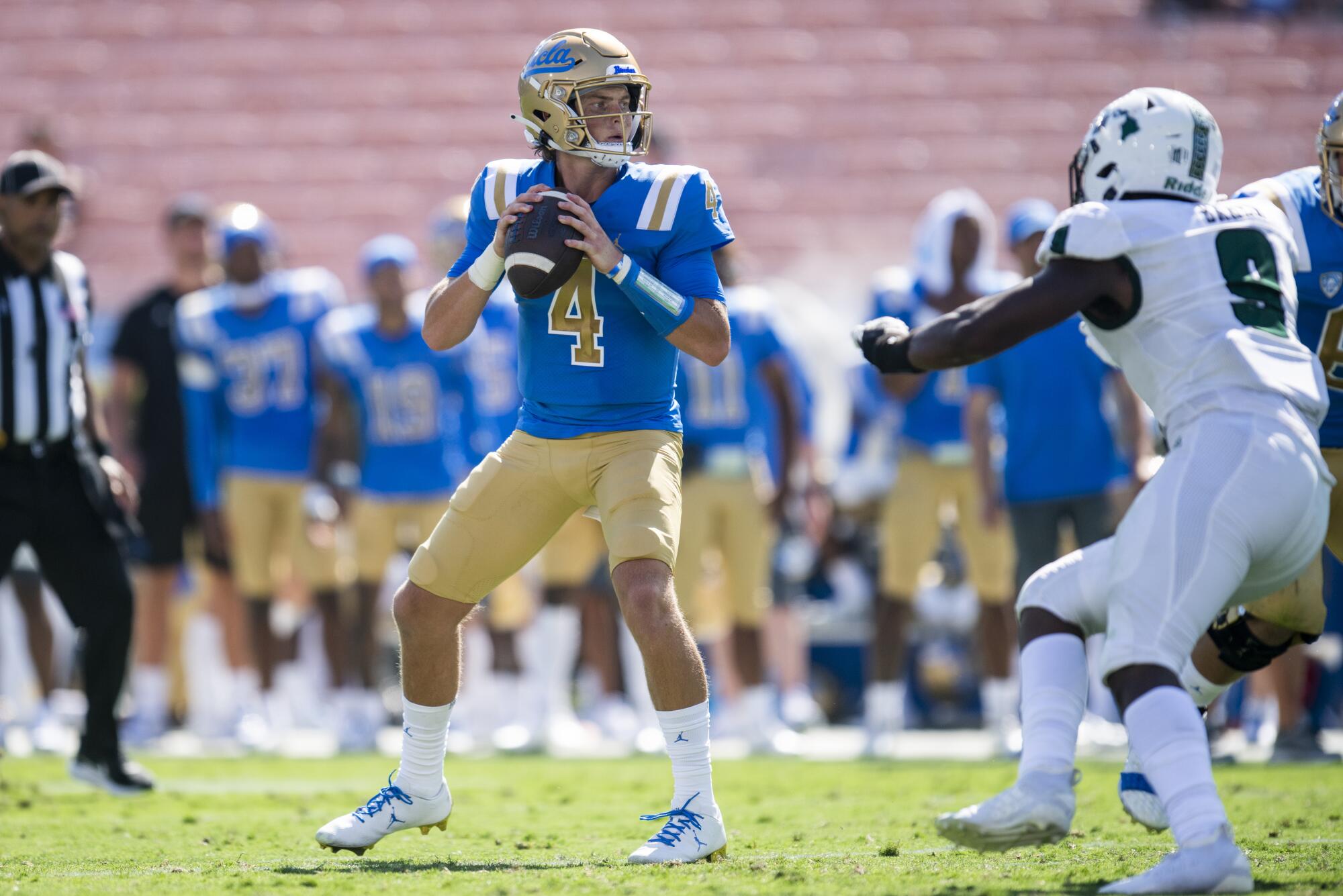
The four-star prospect enrolled for spring ball but lost a quarterback competition to then-redshirt freshman Dylan Morris. Piloting the scout team and living more than 1,000 miles away from his family made for a difficult college introduction. Add in the pandemic that made Garbers and his freshman teammates some of the only first-year students on campus.
“I definitely learned a lot because of the whole COVID thing and all that,” said Garbers, who was named the Huskies’ offensive scout team MVP. “It really opened my eyes.”
After the one season of college football, Garbers could more clearly evaluate what he wanted in a school. He knew he wanted a team with a rich tradition. He hoped to play for a head coach with an offensive background. Going home, where he can visit his empty-nester parents, was a major plus.
All roads led to UCLA.
“I ultimately ended up in the right spot,” Garbers said. “It was a little jagged on the way there, but it just worked out.”
During recruiting, players rarely think of what could go wrong at their school, Barlow said. Transferring is a sign something did.
When he turned down UCLA, Genmark Heath didn’t envision he would come back to the school he wrote off almost immediately as a high schooler. Any coach who mentioned switching Genmark Heath from his beloved safety position meant getting cut from the prospect’s list of options. He was young and naïve, he admits now.
He now feels at home at linebacker, just like how he feels in Westwood.
“It was perfect,” Genmark Heath said of the long road. “I don’t think I would be the same player if I didn’t do it.”
More to Read
Go beyond the scoreboard
Get the latest on L.A.'s teams in the daily Sports Report newsletter.
You may occasionally receive promotional content from the Los Angeles Times.

